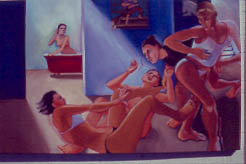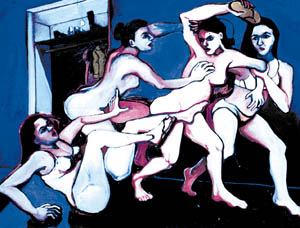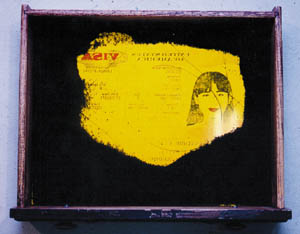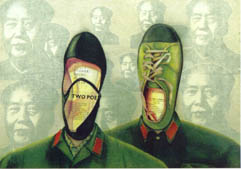|
Art Review
Brawling beauties
The Davis Enterprise
 |
Laura Ball, "Embroilment with a Blond".
|
| |
|
An exhibit of still life and figurative paintings by Davis artist Laura Ball opens Tuesday, July 3, and continues through Aug. 4 at b. sakata garo gallery, 923 20th St., Sacramento. An artisti's reception will take place from 6 to 9 p.m. Saturday, July 14. Ball's show--which includes "Embroilment with a Blond," above--centers around a series of fast-paced, dramatically lit paintings that she calls "The Fighting Girls." Her inspiration for these figures dervied from her interest in the boxing paintings of George Bellows, and also from her submersion in 18th and 19th century Japanese prints of women, notably those by Kitagawa Utamaro. Gallery hours are noon to 6 p.m., Tuesday through Saturday. For further information, call (916) 447-4276.
|
|
Art Review
Three's company
By Jackson Griffith, Sacramento News & Review
 |
Laura Ball, "Bedlam (Sisters #1)", oil on canvas, 2001.
|
| |
|
Whether or not it's true that women will duke it out over the right to buy that sole remaining chic pair of shoes the way that guys might mix it up over, say, the last roast beef sandwich in the house, the image of said rhubarb is a salient one. David painter Laura Ball must know this; her series "The Fighting Girls" depicts such non-finishing school behavior with an ironic wink: riot grrrls, indeed. Her works, and those by two other relatively young area artists--Mark Fox Morgan and Hong Zhong--are currently on display at b. sakata garo, 923 20th St., through August 4. A Second Saturday reception will take place on July 14 from 6-9 p.m.
|
|
Art Review
Mao exhibitor
Hong Zhang, Laura Ball and Mark Fox Morgan at b. sakata garo
By Douglas Slayton, Sacramento News & Review
 |
Hong Zhang, "Three Drawers #1, mixed media, 2001
|
| |
|
The multi-artist introduction show is one of those funny things the art world puts together, primarily as a way to toss emerging talent before the public for viewing. Sometimes these shows are difficult to pull off, given the variety of work often on display. Nevertheless, they’re worth your attention.
This month’s program at b. sakata garo offers such a show, which features three emerging local artists whose work seems quite disparate at first glance. However, upon closer viewing, the show evinces a strong contextual theme that links the works outside a merely formalist agenda. It’s fun to try to figure that theme out.
Hong Zhang’s mixed-media work on paper exquisitely balances the formal and contextual. Although beautiful, adeptly rendered and using gorgeous color, Zhang’s work creates an engaging platform for other important messages about socio-political issues--ethnicity, religion, politics, good old human relationships. Besides Zhang’s sheer mastery of technique, and among the layered meanings, perhaps most compelling may be the artist’s interest in the delicacy of ethnic identity, which manifests in imagery that engages both Eastern and Western ideas such as mass consumerism through iconic images--a fabulous Chanel shoe, American greenbacks with images of Chinese officials instead of George and Abe--that are funny and critical. The reinterpretation of Chinese social realism through images of Chinese leader Mao Tse-tung speaks with neither pro nor con vehemence, opting instead toward an ambivalence of values.
Laura Ball’s mostly figurative oil paintings depict aggressive females on the prowl, sans the company of men, with a few still-life paintings of candies and piles of flip-flops. Although beautifully painted, the taffy paintings and thongs don’t quite compete with the culturally charged images of feminine identity within a decidedly masculine posture and lead us to believe that girls really aren’t (and probably never were) wimps and are disinterested in such behavior. In fact, dealing with issues of feminine beauty is a very current topic among women painters, and Ball’s paintings reference such young female artists who have hit the big time as Lisa Yuskavage, as well as internationally recognized local artist Wayne Thiebaud--under whom Ball studied at UC Davis.
Mark Fox Morgan’s mixed-media collages are the least representational of the three artists’ works shown, but still reference contemporary culture. One of the most compelling aspects of the collages is that the work is delightfully deceiving, very much like culture and its production. Although fabricated from paper, it seems hard--like old scraps of metal that show the vestiges of time through rust and decay, or like post-apocalyptic cave walls. The aging effect, colors and technique are formally engaging without losing a cultural backbone, which manifests through sparse iconic line drawings of familiar objects we all know--bicycles, bottles, even text. These help the work transcend mere decoration to reach a realm of critique on how we interpret stuff around us. It’s not unlike how 30,000-year-old cave paintings from Lascaux, France, depict animals and other magical objects that become a part of our lives.
In short, here are three young artists who are not out just to please our eyes with good formalism (i.e., pretty stuff), but who are obviously thinking about how we as a culture are deciding to live our lives. The choices for this month’s introduction show at the sakata are insightful and are well worth your time.
|
|
 |
"My Parents," mixed media by Hong Zhang.
|
| |
|
Newcomers shine in summer shows: Galleries open walls to some talented university art students
By Victoria Dalkey
Bee Art Correspondent
(Published July 22, 2001)
Local galleries traditionally open their doors to new talent in July. Patterned after San Francisco's successful Introductions exhibitions, Sacramento's program has dwindled this year to only a few galleries. Though the pickings are slim this year, both b. sakata garo and Jay Jay offer a look at some promising newcomers, drawn mostly from graduate and undergraduate programs at California State University, Sacramento, and the University of California, Davis.
At b. sakata, Laura Ball gives us a look at a series of jarring and intense narrative paintings of women in combat. The nude and seminude figures tussle in bedrooms, in one case fighting over a shoe, in scenes that mix aggression and low comedy.
Inspired by Japanese prints and the boxing paintings of George Bellows, the compositions play with the asymmetry and jagged rhythms of the former, and the dramatic clashing of bodies presented by the latter. It's an odd combination and one that immediately draws one's interest. Ball uses a dark yet raw palette that seems more symbolic than observational, striving for emotional rather than optical truth.
Though compelling, there's something ludicrous about these images of blunt, simplified female figures kick-boxing and taking pratfalls that diffuses the sense of menace implicit in the works. Maybe it's just that we can't really believe women would brawl like macho teenage boys or that the stakes -- a shoe? -- are so low.
Hong Zhang presents a series of fragile, surreal paintings that express the social and ideological changes that have taken place in China over three generations: her grandmother's, her mother's and her own. Zhang uses bird cages and shoes as symbols of the suffering and joy of women from three eras.
In one grouping, bird cages, connoting restrictions and constraints, serve as the heads of surreal figures, each with an identifying image within. Her grandmother's cage is filled with a serene image of the Buddha, her mother's with a portrait of Mao, and her own with a shadowy fetus, suggesting both China's one-child policy and her own nascent development as a modern Chinese woman.
The relationship between men and women is the focus of another group. Zhang's grandparents are symbolized by an image of a tiny embroidered shoe for a bound foot perched atop a heavy boot, signifying the way her grandmother was controlled by and reliant on her grandfather. Her parents are depicted as equals, with her mother's cotton shoe and her father's military shoe placed side by side over repeated images of Mao. The relationship between Zhang and her husband is wittily marked by a high-heeled Chanel shoe superimposed over a man's shoe, which stays in the background and serves as a support.
These images could be seen as mere exercises in Magrittean surrealism, save for the extreme care with which they are done and the delicate, transparent quality of the traditional Chinese material -- rice paper, ink and watercolors -- that Zhang uses.
Mark Fox Morgan displays a series of unframed collage and acrylic paintings in rich, saturated colors. In their their wrinkled and rutted surfaces, they suggest relief maps. Unfortunately, they don't show well on the gallery's red brick walls, which swallow them up. The strongest are "Guest Residence," whose painterly surface reveals a palimpsest of cartoony doodles, a map, submerged texts and the word "see"; and "Fishing for Miss Edmeades," whose earthy, rusty tones are broken by markings that suggest cave paintings.
In a crowded show that is a bit too big for its space at Jay Jay, several up-and-comers stand out. Richard Martinez offers a series of paintings on wood, cut out in frilly patterns and employing decorative images -- patterns of foliage and the like -- on rich, tactile surfaces of luminous color. Seductive, sensual and somehow silly in a charming way, they are totally unexpected works. Surprising too are Moira Murdock's spunky, screaming-red wall pieces made of fiberglass and fake fur that suggest bodily sources -- a male torso and a female torso with a deep belly button.
Departing completely from the Northern California tradition of funk art, Dutch-born Nelleke Beltjens presents several works made of cast concrete and steel that have an elegance and formal integrity reminiscent of Bauhaus traditions. Set on the floor, her small forms make one think of architecture, modular dwellings arranged with classical poise. At once beautiful and sterile, they suggest isolation and anonymity without becoming either repetitive or didactic.
George Bows offers a restrained yet raunchy ceramic and mixed-media piece in the form of a panel covered with a photocopy design that suggests pajamas on which a series of plates with subtle glazes are mounted, so that when the light is just right you can see inscriptions that are not suitable for a family newspaper.
Its snide humor contrasts with Lauren Kline Ari's life-affirming installation of small ceramic figures, at times suggesting angels, arranged to form a human head on the wall. These tiny figures, reminiscent of European and Mexican folk art figures, have a kindred feeling to Kandinsky's emotionally rich abstract paintings. Titled "The Gift," it has a nurturing, spiritual presence.
|
| | | |